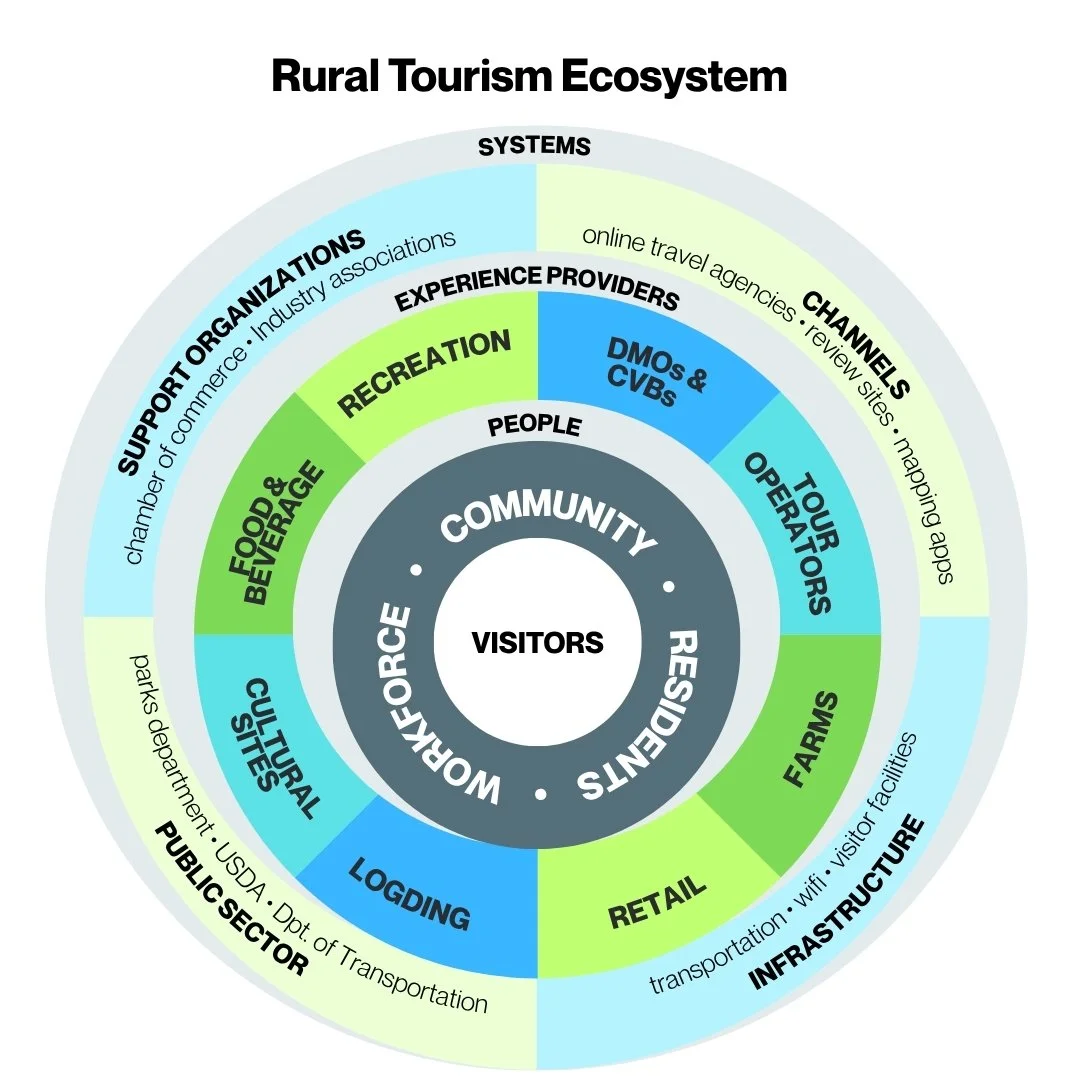Rural Tourism in the USA: An Overview
Introducing Rural Tourism Network
Across the United States, the rhythm of travel is changing. Long‑established city breaks and coastal resorts still draw crowds, yet more Americans than ever are visiting farm lands, historic towns, and trailhead hamlets that once sat well outside the tourism spotlight. At Rural Tourism Network (RTN) we believe those detours are more than a pandemic‑era trend; they represent a structural shift in how, and where, people choose to spend time and money.
RTN is a community‑driven organization created to bring together the many professionals and residents who make rural travel possible. This newsletter series will track rural tourism’s evolving landscape, spotlighting what makes this sector distinct and why it matters. Our first issue offers a snapshot; defining rural tourism, surveying core activities, and outlining the industry’s overall structure. We encourage feedback to keep the discussion moving forward and grounded in lived experience. Together we can map a clearer, more coordinated future for rural destinations everywhere.
What Is Rural Tourism?
Rural tourism in the United States is both widespread and surprisingly hard to pin down. Most trips to campgrounds and back‑road festivals never show up in national datasets, yet their economic signal is hard to miss. In 2023, travelers to national parks spent $26.4 billion in nearby towns and supported 415,000 jobs [1]. Short‑term‑rental data add another lens: in 2022, 44 million guest arrivals were recorded in counties with no hotels, generating $10.5 billion for local hosts [2]. These figures alone hint at a market far larger than many urban‑centric reports suggest.
Because federal surveys rarely label a trip as “rural,” analysts depend on proxy measures such as state‑park visitor counts or lodging earnings in hotel‑free counties to gauge the sector’s scale. Tourism serves as a major economic engine in many rural areas, often outpacing traditional sectors by delivering stable revenue, creating vital jobs, and supporting community resilience through diversified income sources. Although it rarely happens, viewing tourism through this lens matters: rural communities, many facing infrastructure gaps and seasonal economies, stand to benefit from accurate data and tailored policy. Recognizing those distinct conditions is the first step toward investments that match rural realities.
To make sense of rural tourism, start with two reference points. According to the U.S. Department of Agriculture, a county is classified as rural when it contains no urban area of 50,000 or more residents [3]; that covers roughly 60% of U.S. counties and 97% of the nation’s land area. Tourism researchers then add a travel-distance rule: a leisure trip counts when a visitor goes at least 50 miles from home [4]. Together, these thresholds outline the vast geography and movement patterns that give rural tourism its scale.
What to Do in Rural America
Because rural America is diverse, it invites countless ways to explore it. Outdoor recreation is one of the largest components of rural tourism. In 2023, according to the U.S. Bureau of Economic Analysis, it generated $1.1 trillion in gross output,about 2.2 percent of U.S. GDP,and most of that activity (camping, boating, hiking, hunting, and snow sports) took place in rural counties [5]. National parks remain the main draw, yet some of the fastest growth now happens beyond park boundaries: rails‑to‑trails bike corridors in Wisconsin log tens of thousands of overnights each summer [6], a Utah dark‑sky sanctuary sells out its astronomy programs a year ahead, and winter Fat‑Bike races in Michigan’s Upper Peninsula pull visitors in during months once reserved for locals.
Beyond outdoor recreation, rural communities excel at showcasing culture and heritage through immersive experiences. In New Mexico, Chaco Canyon’s ancestral Pueblo sites guide visitors through ancient stone villages and ceremonial kivas, while in Illinois, Cahokia Mounds brings to life the world’s largest pre-Columbian settlement north of Mexico. Elsewhere, community-led events, from small-town folk music series to regional craft fairs, invite guests into local traditions, from pottery workshops to storytelling circles. These cultural journeys celebrate the people, history, and creativity that define rural America, offering travelers a connection that goes beyond scenery to the heart of place.
Additionally, everyday rural life itself is becoming a marketable experience. Social media trends have cast rurality in a new light, turning everyday activities into aspirational escapes. Hashtags such as #Cottagecore and #HomesteadLife invite followers to join farm stays for farm‑to‑table meals, orchard pick‑your‑own lanes, and hands-on fiber workshops. Parallel movements like #VanLife and #TinyHouse showcase minimalist road trips and off‑grid cabins. Additionally, rural communities excel at hosting retreats, wellness weekends, corporate off-sites, and creative workshops, which leverage quiet landscapes to rejuvenate both leisure and business groups. These trends highlight rural traditions and landscapes, encouraging travelers to seek out authentic experiences that blend cultural practices with modern adventure.
How the Rural Tourism Industry Works
Rural tourism works best when every part of the ecosystem works together. At the center of every tourism experience is a visitor, whose journey is supported by the local community: residents and front‑line workers who host festivals, maintain trails, and decide whether tourism fits local values. Treating the community as co‑owners of the destination, not passive bystanders, is essential for sustainable tourism. Community input shapes priorities, residents help define which sites to promote, what infrastructure to build, and how to balance visitor needs with local traditions. When local residents guide decisions, tourism growth reflects shared goals, builds local trust, and ensures benefits reach the people who know the place best.
Experience providers enable tourism by converting community assets into bookable journeys. They work hand in hand to shape a cohesive visitor experience; coordinating schedules, cross‑promoting one another, and packaging local assets into seamless offerings. For example, a historic farm may partner with a nearby bed‑and‑breakfast to offer agritourism packages that include guided apple-picking; outfitters supply transport and equipment; and the local Destination Marketing Organization ensures these offerings appear on mapping apps and tourism guides. Through shared joint marketing and information exchange, these organizations create an experience that feels effortless for visitors and maximizes economic benefits for the community.
The relationship between residents and tourists depends on a coordinated network of support systems. These include organizations that build local capacity, agencies that maintain essential services, and platforms that circulate insights across stakeholders. When these elements align, ensuring that needs, feedback, and data move freely,rural communities can proactively guide visitor growth, balance resources, and reinforce the local identity that draws people in.
A typical visitor journey starts when a traveler discovers a destination through mapping apps and online travel agencies, plans itineraries with an AI chat bot, and books an experience online. Once there, they spend money at cafés, farms, and outfitters that rely on local suppliers and employees. Sales taxes and room levies collected along the way flow back to public coffers, funding trailheads, signage, and cultural grants that refresh the visitor offering. Complementing local revenue, state and federal agencies provide grants, infrastructure funding, and policy guidance that support sustainable tourism development and help small communities leverage their assets effectively.
Conclusion
Rural tourism, at its core, is travel beyond urban centers into the backroads, small towns, and working landscapes that make up most U.S. counties. Its activities stretch from hikes and paddles to farm dinners, music festivals, and craft studios, all rooted in communities that highlight their own heritage and environment. When residents, experience providers, and support systems move in sync, visitor spending returns as local jobs, better public services, and new reasons for cultural pride. Even modest growth in this sector can diversify rural economies and help sustain the stories and landscapes that define them.
If you found this overview valuable, please subscribe, share with a colleague, and send us feedback on what you would like to explore next. Look out for out our next Newsletter!
The road ahead is long, scenic, and, as every traveler knows, best navigated with good company.
— The RTN Team
Feedback Form
Sources
National Park Service. Visitor Spending Effects 2023. https://www.nps.gov/subjects/socialscience/vse.htm
Airbnb. Rural Stays in the United States 2023. https://news.airbnb.com/rural-us-hosts-earned-10-5-billion-in-2022/
USDA Economic Research Service. Rural‑Urban Continuum Codes. https://www.ers.usda.gov/topics/rural-economy-population/rural-classifications/
Bureau of Transportation Statistics. National Household Travel Survey Methods: Defining Long‑Distance Trips. https://www.bts.gov/statistical-products/surveys/national-household-travel-survey
U.S. Bureau of Economic Analysis. Outdoor Recreation Satellite Account, 2023. https://www.bea.gov/data/special-topics/outdoor-recreation
Rails‑to‑Trails Conservancy. Virginia Creeper Trail User Study 2023.https://www.railstotrails.org/resource-library/resources/virginia-creeper-trail-user-study-2023/



